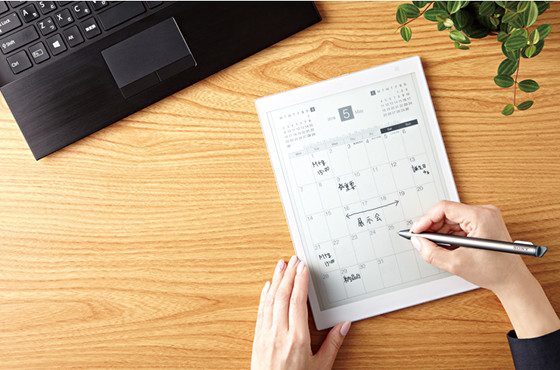Sony has a new Digital Paper device listed on their Sony Japan website called the Sony DPT-CP1.
It’s basically a 10.3-inch version of the 13.3-inch Sony DPT-RP1 that was released in June 2017.
This new model is expected to get released in early June in Japan, and if last year is any indication it could get released in the US a couple weeks later, although there’s been no official word yet.
Aside from the screen size difference, the specs on the Sony DPT-CP1 are identical to the RP1.
It has the same quad-core processor and it comes with 16GB of internal storage space, with no memory card slot. It has dual-band Wi-Fi, Bluetooth 4.2, and an NFC chip.
It has a capacitive touchscreen for finger touch, along with a stylus pen to write notes and make highlights.
The 10.3-inch flexible E Ink screen has a resolution of 1404 x 1872, which equates to 227 ppi. That’s 20 ppi higher than the larger model.
The software is most likely 95% the same as the RP1, but hopefully it comes with some updates. One thing mentioned on the features list is a smartphone app to transfer content. That’s a plus because the RP1 could only have content transferred from a computer.
One of the most impressive things about the Sony DPT-CP1 is the fact that it only weighs 240 grams. That’s over 100 grams lighter than the RP1, and it’s also over 100 grams lighter than the Remarkable paper tablet, which has same size 10.3-inch screen. In fact the 6-inch 3G Kindle Paperwhite weighs 217 grams, so 240 grams is really impressive for a device that large.


Weight sounds nice, but except that it sounds like it’s actually going to be worse in all respects that are of relevance to me than the Onyx Note.
Judging by what I hear about the larger device, there’s no straightforward way to access the internal storage except via Sony’s cloud and some Wifi solution with a Windows client (and maybe MacOS? crucially no Linux, afaik).
Closed system, so no way of installing own apps or get a (even makeshift) external monitor solution to work.
Small internal memory and no way of extending by MicroSD.
The Onyx Note is not flawless either (also lacking Micro-SD and still no root access as far as I know), but at least it has a slightly more manageable 32GB memory and an open (albeit currently non-rooted) Android system, allowing access to internal memory and possibly even use as external Screen via VNC. So unless someone convinces me of the utility of the Sony device, I don’t see any reason to buy into this. Might be different for people who definitely have no other plans with the device than take notes on PDFs ONLY and use Windows.
If someone manages to open up the underlying Android, it might be a bit more interesting, but the lack of memory (and possibly lack of touch support, not sure if pen alone is sufficient) would still hold it back even then.
I do not mind if I can not run apps (thats what I use phones, iPads, Macs and Surfaces for), and really looks like a nice device from a hardware standpoint. Really looks to be awesome.
What kills it for me is that it only supports PDF and no e-reader formats.
I just hope they update the RP1 software to this. I have no complaints with my RP1 but the mobile share app would be a nice addition.
James, does your RP1 only read pd? Does it read Sony and epub?
That would entice me to purchase the CP1.
They are strictly PDF readers. No other formats are supported.
OK. Thats really too bad. No Sony for me.
Will buy a dedicated e-reader instead (note taking and running apps I do on my iPads and Surfaces). Kobo and Kindle looks best.
Only pdf. But if you have the ePub file you can use calibre to convert them to pdf, I find it works quite well. I often convert ePub books I have to read on my DPT, way better than my iPad.
My other use cases are reading pdf mathematics textbooks and journals as well as extensive note taking (the nibs last longer than people complain, I use the pencil like ones).
It’s my favorite piece of technology I’ve ever owned.
I will admit the software has some odd quirks. Table of contents is the only feature I wish it had, maybe in software update some future timeline.
The hardware still outshines the software and makes it beneficial to use for me.
I have used Calibre a number of times to change an EPUB doc to a PDF doc for reading on a Kindle DX. My experience with converting to PDF is that I get better results from Calibre EPUB by using Microsoft DOCX as an intermediate step. EPUB to DOCX to PDF gives better results than EPUB to PDF. In addition, I find it easier to change font and font size in DOCX.
I would love a good pdf reader for marking up pdfs when I go to conferences, but the price of the larger one, as well as the remarkable, were way too high for me. Any idea on the price point for this?
70,000 yen, only in Japan. There is no indication of whether/when it may be available in the Untied States. As I recall, the DPT-RP1’s U.S. release was sometime after its Japan release.
My guess is a $100 less then the current DPT, so $599 usd. Just a guess though.